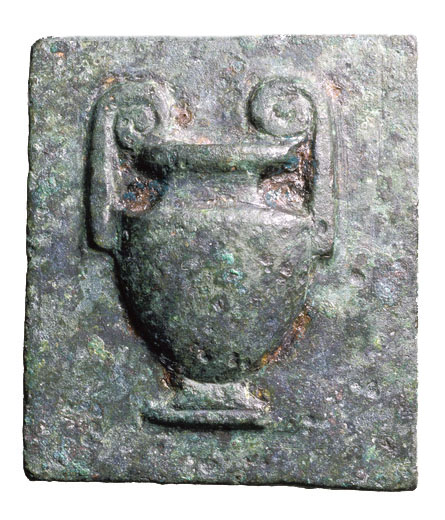
-
Copyright credit: J. Paul Getty Museum

ARCHAEOLOGICAL DESCRIPTION OF THE WEIGHT
Authority
Mint
Denomination
Material
Copper alloy (bronze or brass)
Manufacture
Cast
Shape
Square
Length
2.86 cm
(1.125 inch)
Width
2.38 cm
(0.9375 inch)
Height
0.48 cm
(0.1875 inch)
Metrology
| Mass (g) | Mass (grain) | Date of measurement | Reference | fragmented | cleaned | reference weight |
|---|---|---|---|---|---|---|
| 317.51 | 4900.0006 | - | www.getty.edu | No | No | Yes |
Iconography
| Symbol | Technique | Direction | Position | Number | Synecdoche |
|---|---|---|---|---|---|
| Volute krater | Relief |
Wear
Corrosion
Handle
No
Suspension hole
No
Recarved mould
No
Recarved weight
No
Intentionally destroyed
No
Archaeological description
A volute-krater in high relief decorates one side of this Greek bronze weight designed for use with a simple balance scale. The other sides of the small plaque are plain, except for the underside, which was hollowed out either to lighten the weight or for the addition of a lead filling. The commercial weights used by merchants and shopkeepers of this period were usually made from lead, so this bronze example probably had some sort of official status, serving as a standard against which other weights could be checked. Like coins, most Greek weights had a symbol on one side to easily identify their value. The symbol of a volute-krater appears on the reverse of silver stater coins from the city of Thebes in central Greece. Since the coins and the official weights of a city both originated at the same mint and often used the same emblems, this weight probably comes from Thebes.
Autopsy
No
INSCRIPTION
| Language | Technique | Legend type |
|---|
Fac simile
Edition
Monogram
ARCHAEOLOGICAL CONTEXT
Findspot (region)
Findspot (site)
context
CIRCUMSTANCES OF ACQUISITION
Region
City
Date of first acquisition
Dec. 31, 1996
circumstances
Gift of Barbara and Lawrence Fleischman (New York, 1925 - New York, 1997) to the J. Paul Getty Museum in 1996. Sold to Barbara and Lawrence Fleischman in 1992, Galerie Nefer (Zurich, Switzerland).
DATING OF THE WEIGHT
Curatorial Section
GREEK
Time frame
FROM
-500
TO
-300
Comments on Chronology
Fourth quarter of 5th century B.C
COLLECTION HISTORY
Collection
| Name | Date of acquisition | Inventory number |
|---|---|---|
| Fleischman Collection | Jan. 1, 1992 | F299 |
| Getty Museum – Getty Villa (Malibu) | Jan. 1, 1996 | 96.AC.84 |
Bibliography
| Reference | Page/Column | Reference (number) | Plate / Figure | Comment |
|---|---|---|---|---|
| True and Hamma 1994 | 71 | 26 | ||
| Getty Museum 1997–98 | 64 |
VARIA
Additional comment
Mint: Myrina? or Thebes?
Permalink